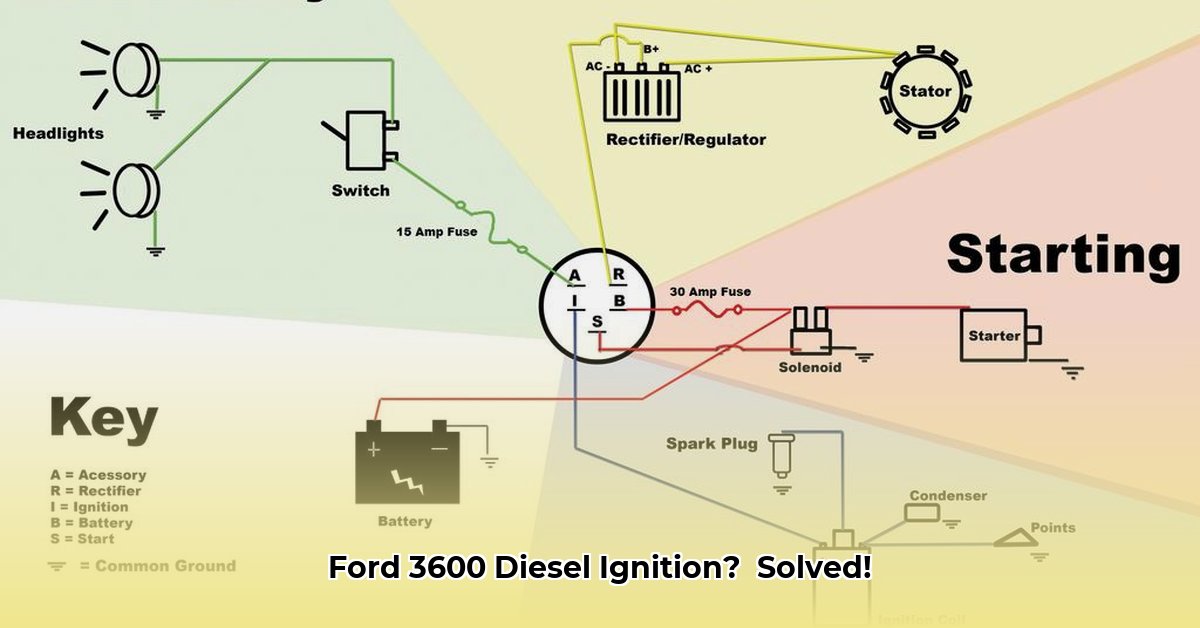
Diesel Tractor Ignition Switch Wiring: Troubleshooting Your Ford 3600
Is your trusty Ford 3600 diesel tractor refusing to start? A faulty ignition switch wiring is a common culprit. This guide provides step-by-step instructions to diagnose and fix the problem, helping you get your tractor back in operation. We'll navigate the complexities of older tractor wiring, minimizing frustration and maximizing success. For more detailed Ford 3600 information, check out this helpful resource: Ford 3600 Specs.
Understanding Your Tractor's Electrical System: A Simplified Approach
Think of your tractor's electrical system as a network of pathways for electricity. The battery acts as the main power source, supplying current to various components. This power is distributed through wires, feeding essential functions like glow plugs (which preheat the engine for easier starting), lights, and the starter motor (which cranks the engine). These pathways are often color-coded for easier identification. Understanding this basic flow is crucial for effective troubleshooting.
Tracing the Wiring: A Systematic Approach
Instead of relying solely on potentially inaccurate wiring diagrams, let's adopt a hands-on approach. We'll use a multimeter (a device that measures voltage and continuity) to systematically trace the electrical path. A test light can also be useful for identifying live circuits.
Step 1: Battery Check: Disconnect the negative battery terminal for safety. Using your multimeter, verify the battery voltage is within the acceptable range (typically 12V). A low battery can mimic other problems.
Step 2: Main Power Feed: Check the main power feed from the battery to the ignition switch. This is usually a thick red wire. Is there power at the switch?
Step 3: Glow Plug Circuit: Turn your ignition key to the pre-heat (glow plug) position. Use your multimeter to verify power reaches the glow plugs. Lack of power here points to a problem in that circuit.
Step 4: Instrument Panel Lights: With the ignition switch in the "ON" position, check if the instrument panel lights illuminate. If not, there's a problem within the ignition-to-instrument panel circuit.
Step 5: Starter Motor Circuit: Turn the key to the start position. Does the starter motor engage? If not, there is a fault in the ignition switch-to-starter motor circuit. A lack of starter action may indicate a problem with the starter solenoid or motor itself.
Step 6: Wire Tracing and Continuity Checks: Use your multimeter's continuity function to check for breaks or poor connections. This involves placing one multimeter lead at one end of a wire and the other lead on the other end. A good connection shows a clear continuity (usually a beep or a reading of zero ohms). Carefully follow each wire.
Addressing Aftermarket Ignition Switches
Aftermarket ignition switches may have different wiring configurations than the original. Thorough testing using a multimeter is essential to understand how power flows through the system. Matching wires according to color codes as shown in the provided wiring diagrams may not be sufficient.
Common Problems and Solutions: Quick Troubleshooting Guide
| Problem | Possible Causes | Solutions |
|---|---|---|
| No glow plug power | Faulty glow plug relay, wiring issues from the battery to the relay | Check the relay and wiring; replace if necessary. |
| Starter motor doesn't engage | Problems with the ignition switch, starter solenoid, or starter motor itself | Test each component; replace faulty parts. |
| Instrument lights don't work | Faulty wiring between the ignition switch and instrument panel | Check wires and connections; repair or replace as needed. |
| Intermittent starting | Loose or corroded connections, worn wiring | Clean and tighten connections; replace any damaged wiring. |
Safety First: Always disconnect the negative battery terminal before working with the tractor's electrical system.
The Elusive Safety Starter Switch
Some Ford 3600 models include a safety starter switch (often labeled #17), frequently a neutral safety switch, preventing the engine from starting unless the transmission is in neutral. Failure of this switch can cause starting issues. Testing this switch (often using a multimeter for continuity testing) is recommended if other issues have been eliminated.
Putting It All Together: A Step-by-Step Repair Approach
- Disconnect the Battery: This is a crucial safety precaution.
- Gather Tools: You will need a multimeter, test light (optional), and the necessary wiring diagrams.
- Visual Inspection: Look for any obvious signs of damage in the wiring (like cuts, corrosion, or loose connections).
- Systematic Testing: Follow the wire tracing steps outlined to identify the exact fault location.
- Repair or Replace: Repair any damaged wiring or replace broken parts as needed.
- Reconnect the Battery: Reconnect the battery once the repairs are complete. Test the entire system to make sure that the issue is resolved.
Remember, patience and a methodical approach are key to successfully troubleshooting your Ford 3600's ignition system. By carefully tracing the wires and using your multimeter, you can pinpoint the problem and get your tractor back to work.